How do we look for life beyond Earth? And how did it first get started down here? To help us take on these big questions, we explore the science of SETI and the chemistry of creating life. Plus, science gets cinematic as we meet the scientific adviser for Prometheus, and find out how his work could help us understand alien atmospheres. In the news, how to sequence a baby using just the mother's blood, and the simple intervention that could prevent millions of malaria cases. In Question of the Week, can we create life in the lab from just elements and heat?
In this episode
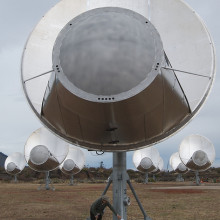
01:38 - The Search for Extra Terrestrial Intelligence
The Search for Extra Terrestrial Intelligence
with Dr Jill Tarter, Director of the SETI Institute
Chris - In a 1959 paper entitled "Searching for Interstellar Communications", published in the journal Nature, two Cornell researchers, Guiseppe Cocconi and Philip Morrison opened by saying:
"No theories yet exist which enable a reliable estimate of the probabilities of (1) planet formation; (2) origin of life; (3) evolution of societies possessing advanced scientific capabilities. In the absence of such theories, our environment suggests that stars of the main sequence with a lifetime of many billions of years can possess planets that, of a small set of which, two (Earth and very probably Mars) support life, that life from one such planet includes a society recently capable of considerable scientific investigation...
It follows, then, that near some star, rather like the Sun, there could be civilisations with scientific interest and with technical possibilities much greater than those now available to us...
We shall assume that long ago [such civilisations] established a channel of communication that would one day become known to us, and that they will look forward patiently to the answering signals from the Sun which would make known to them that a new society has entered the community of intelligence. What sort of a channel would it be?"
Jill Tarter is the outgoing Director of the Search for Extraterrestrial Intelligence or SETI and she's with us from California. Hello, Jill.
Jill - Hello there, Chris.
Chris - What were the channels of communication that Guiseppe Cocconi and Philip Morrison were discussing? What channels are you using and have gone on to use over the last 50 years?
Jill - Well, a lot has changed since that original paper. First of all, we now know about planets. Planets are everywhere and it's where we're pointing our telescopes. How are we listening? What channels are we imagining? Well, Cocconi and Morrison figured there would be one radio channel at a frequency of about 1420 megahertz, the frequency of the hydrogen atom, the most abundant element in the Universe. And indeed, the first radio search was done one year later in 1960 using a single channel around that frequency.
Today, we use hundreds of millions of radio channels and we search a range of radio frequencies that happen to be a quiet window that nature provides us on the Universe. But it's not just radio. Today, we're also using optical telescopes to look for laser signals and my colleagues here at the SETI Institute in the Sagan Centre for the Study of Life in the Universe, they're not looking for techno-signatures, which is what my group has been looking for, but they're looking for bio-signatures. They're trying to figure out whether there are microbes out there as well as mathematicians that could build transmitters.
Chris - So what's the actual infrastructure of SETI like? Is it a massive network of interconnected telescopes that share the data that they're outputting or do you have certain facilities in certain places? How does it work?
Jill - Well, SETI is a discipline. The SETI Institute is one practitioner of that particular discipline and at the SETI Institute, we have built a telescope called the Allen Telescope Array in northern California which has been built with SETI in mind from its inception. We use that telescope 12 or more hours a day with automated signal processing systems that look for narrow band signals; the kind of thing that we don't think nature can produce, but that our technology does all the time. We point our telescopes in the directions of these newly discovered exoplanets from the Kepler spacecraft and from ground-based observatories.
Other places such the Berkeley SETI group use receivers on the large radio telescope in Arecibo. They record a little bit of data continuously and they allow people to massage that data with a screensaver on their laptops at home. Other SETI organisations use telescopes in Italy, some in Australia, in Argentina. There's been a little work in Japan, LOFAR in the Netherlands and northern Europe and the UK - it's coming online with a low frequency radio search. And then there are other observatories, primarily university based, that look for bright optical flashes with metre-class visible telescopes. That is the scope of SETI today. It's not at all monolithic. We try to organise collegially, but there are a number of groups doing their own thing.
Chris - So it's not just confined or constrained to one particular way of looking for signals. You're actually running across the whole spectrum, aren't you? But space is a massive place, so is it just that we're seeing our message being lost in the medium? There's so much space out there that we just can't scan all of it at the right time to hear what we need to hear?
Jill - Well, we haven't done so yet. Although 50 years of searching sounds like a long time to most people, we've hardly begun to explore the 9-dimensional space that electromagnetic signals can exist in. A good analogy, if you wanted to sum up all of that search space and say that's the cosmic ocean that we'd like to explore and then you make the analogy with the Earth's oceans, over 50 years so far, we've scooped about one 8 ounce glass of water from those oceans and examined it. But our tools, our glasses, are getting better much faster, exponentially faster than in the past. And so, over the next decade or two, we should have tools that are commensurate to this huge search, and if we're looking for the right thing, then we have a good chance of finding it - if it's there.
Chris - It also presupposes that if we can pick something up, that such a civilisation has been capable of sending these signals for a very long time, because the Universe is a finite age. It's 13.7 billion years old, give or take a few, and if other civilisations are going to get to this stage where they can begin to send signals of the type that we would be able to receive and decode, they must have existed for a very long time already, because of the finite speed of light coming across space to get to us. Does that not put some constraint on what really is possible?
Jill - You're correct. We are the youngest kids on the technological block. We are just emerging with the capabilities to try and participate in some sort of interstellar exchange. Most of the stars in our region of the galaxy are probably even a billion years older than the Sun. So, even locally, there will have been opportunities for another technological civilisation to start up before ours did here on Earth. Having said that, we're still constrained by what we know in the 21st century. We can use the tools that we have. We can try to imagine other tools and eventually, if we invent some new technology that seems to make sense for interstellar discussions, then we'll use that too. But right now, the limitation is on us, on the receiving end, given what we know about the universe and the technologies we have at hand.
Chris - And how do we actually interpret the data? How do we look for something that's meaningful? Are we looking for something which is meaningful to us, but if we were a very different alien species, it would be meaningful, but would mean nothing to us? Is that a possibility: we're just missing something?
Jill - Well, we're using computers to look at the data and therefore, they're finding what we programme them to look for. And in our case, what we're doing is, we're looking for patterns. We're looking for patterns in frequency and time that don't seem to be able to be produced by natural astrophysical emission processes. That is, we've looked at the Universe, we've looked so far at what we know about how molecules and atoms in conglomerates can produce signals, and we've carved out a corner of phase space where nature doesn't seem to be playing. So, if we find these signals, they'll be obviously engineered.

10:53 - Alien Atmospheres and producing Prometheus
Alien Atmospheres and producing Prometheus
with Dr Hugh Mortimer, Rutherford Appleton Laboratories
Kat - We're looking for life elsewhere in the Universe this week, and, right on cue, Hollywood have spawned a potential blockbuster in the form of Prometheus, where director Ridley Scott returns to the world of the 1979 cult film Alien... Sounds exciting! But it's also based on hard science.
Dr Hugh Mortimer works on the atmospheric chemistry of planets both inside and outside our solar system. He's based at the STFC's Rutherford Appleton laboratory, but he also consulted for the makers of the film to help them to get the science right. He joins us now. Hi, Hugh.
Hugh - Hi, Kat.
Kat - So, how did you get roped into this?
Hugh - I was pretty lucky in the fact that I was in the right place at the right time. I'm the Chairperson of a body known as the UK Planetary Forum, which essentially looks after all of the planetary scientists in the UK and we represent their interests to the rest of the world. What that means is that we got approached by the researchers at the Prometheus film and we could give them direct information about the real science going on in the discovery of exoplanets.
Kat - So, what sort of things did they need to know?
Hugh - They were looking to find out the true facts behind what happens in the universe. When it came to giving them research, we had to adjust what we were doing, what we told them, because these - the directors, the people in charge of producing the special effects - they're essentially artists, they don't necessarily know the fundamental science behind it. And so, myself and various other scientists were involved in actually giving them direct hard facts about what - not only space, but other aspects of science - they could use realistically.
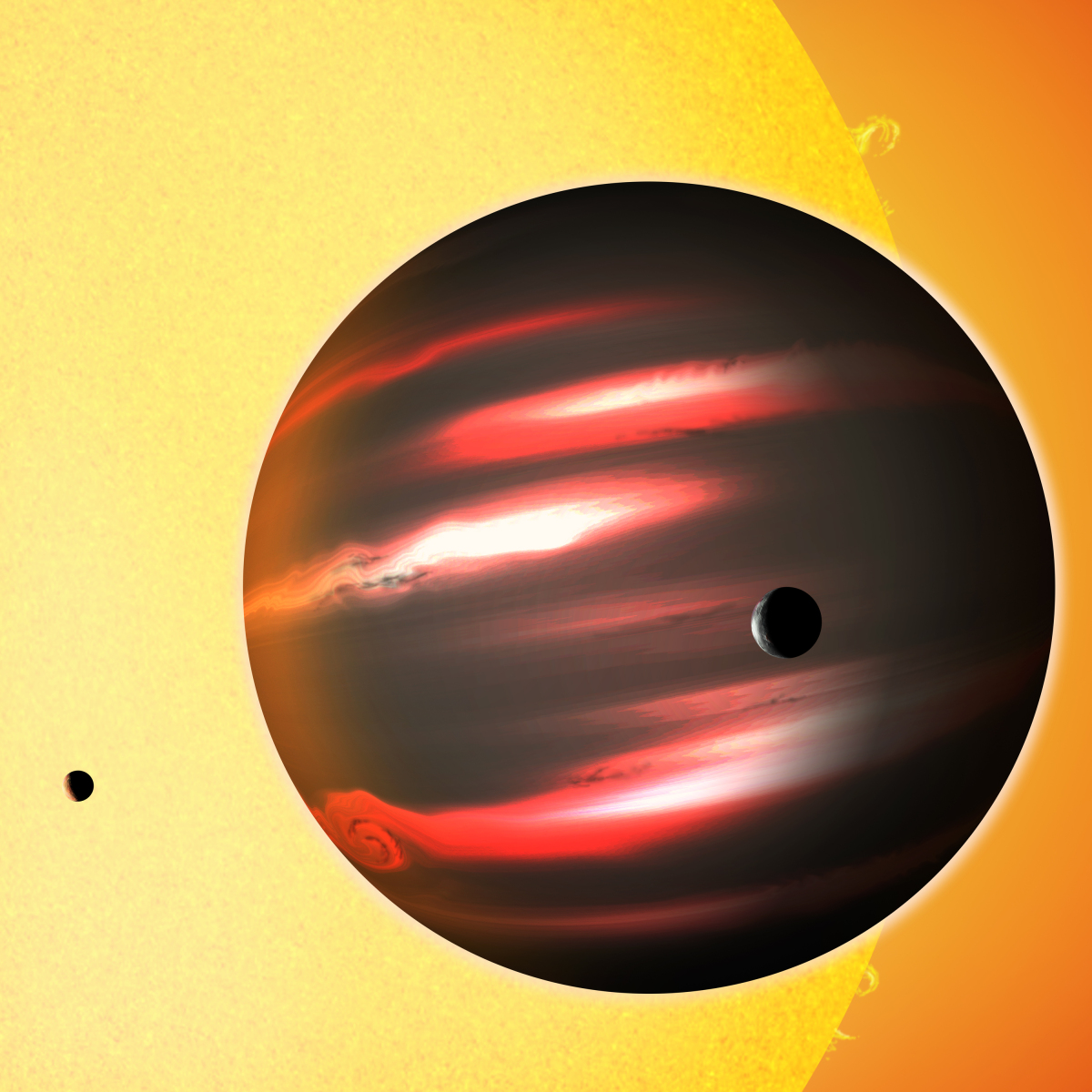
' alt='The distant exoplanet TrES-2b, shown here in an artist's conception, is darker than the blackest coal.' >Kat - Give me some examples. What sort of things would the designers or the actors have to take into account?
Hugh - So, what we're looking for is essentially giving the film some traces of reality in terms of space. We were giving them information about what the exoplanets would look like, what the constellations would look like as they flew from Earth, all the way over to a planet orbiting Zeta II Reticuli. What they actually wanted from us was actual simulations of what space looks like as you travel from Earth to this planetary system. And actually, the film is based on two real binary stars. So, where the astronauts and the scientists in this particular film go is to a real star system. It's found in the southern hemisphere. It's known as the two stars, Zeta I and Zeta II Reticuli, found in the constellation of Reticuli. This is about 39 lightyears away from Earth. You might not expect the constellations to change, the locations of the stars to change that much, but incredibly they do and amazingly, the directors of the special effects took our information, the simulations that we produced, and actually created them into the star maps and actual imagery that you see as the ship travels from Earth to this particular planet.
Kat - So, to go from fictional space to real space and look at your research, you said that you advised them on what the atmospheres might be like on these exoplanets. How do you actually figure that out, because say, with Mars, we can send a probe to Mars and go, "Oh, the atmosphere is made of this." How on Earth do you figure that out for a planet that's lightyears away?
Hugh - So, how I like to think about science is that we're kind of detectives; we're using information around us to try and infer different aspects of the properties of, for example, different planetary atmospheres. We use techniques similar to how our eyes detect different colours in the world around us. We use spectroscopy to look at the infrared light. As the light from these planets many, many lightyears away from Earth travels, it is detected by instruments on space-based telescopes and ground-based telescopes. We can actually analyse the wavelengths associated with those planets. We use a couple of techniques to actually detect the planets. One is, where the planet, as it orbits around the star, creates a transit and as that planet travels in front of the star, we get a slight dip in the light that actually reaches the Earth. And we can measure the light that passes through the atmosphere of that planet and detect the atmospheric components, look at the particular gases based on the spectra that it produces. Each gas within that atmosphere produces a specific spectral line and in using that spectral line, we can actually understand the components of the gas. So these are planets, many, many lightyears away from Earth and they are small compared to the star that they're orbiting. And so, we're using very small amounts of light to actually infer this data.
Kat - I guess the 64 million dollar question is, you're looking for something like oxygen that might infer the presence of life or water. What tend to be the main gases that you see and have you seen water anywhere?
Hugh - Bringing back Prometheus, the synopsis for the film is quite interesting in that it's asking the big questions. It's looking for the origins of life and so - this film was based on scientists in the future - getting aboard a ship and trying to find the creators of life on Earth. Those are the kind of questions that actually drive scientists in exoplanetary research. What we're trying to do is find those specific planets that could hold and potentially have life on them. So we look for the key indicators of oxygen, water vapour, carbon dioxide, methane: greenhouse gases that can only be produced by organisms that digest and ingest different types of chemicals. We've spotted several different planets and the spectra give us information about CO2 content and CO content. But at the moment, we're out of the range of the sizes of planets and types of planets: how close they are to the star. So what we're looking for are planets in a particular region that could host life.
Kat - You strike it lucky soon, so thank you very much. That's Hugh Mortimer from the Rutherford Appleton Laboratory.

17:50 - Baby's genome sequenced before birth from mother's blood
Baby's genome sequenced before birth from mother's blood
Using blood from a mother midway through her pregnancy, researchers have successfully sequenced the complete genome of the woman's unborn child.
Writing in the journal Science Translational Medicine, University of Washington, Seattle,  scientist Jay Shendure and his colleagues have published their approach to reading the genetic blueprint of a developing baby by piecing back together DNA fragments washing around in the maternal bloodstream.
scientist Jay Shendure and his colleagues have published their approach to reading the genetic blueprint of a developing baby by piecing back together DNA fragments washing around in the maternal bloodstream.
The approach, which according to Shendure cost about US$50,000 to complete, involved three separate phases of genetic sequencing.
First, DNA extracted from saliva samples was used to compile the complete genomic fingerprint of the father, while DNA from white cells in the mother's peripheral blood provided the maternal sequence. For the mother, the researchers also painstakingly decoded the DNA sequence from each of her 23 pairs of chromosomes - this is called the haplotype - so that they knew exactly what DNA sequences were sitting alongside one another.
The team then also sequenced the DNA contained in the cell-free plasma from the maternal blood sample; by this stage of pregnancy, over 10% of the DNA it contains is of foetal origin.
This produced a mixture of sequences, some of which were maternal, others foetal. But because the researchers knew the maternal sequence in detail, and what sequences were present in the father, it was possible to pick out and reassemble just the foetal DNA code. And this also meant that 39 new genetic changes (mutations) carried only by the developing baby were also predicted.
To check their results, the researchers matched up their sequences with the a version of the child's genome produced using a blood sample from the umbilical cord collected after the child was born.
The accuracy of the procedure was over 98%, meaning that it could be employed as a minimally invasive means of genetic screening without the miscarriage risks associated with amniocentesis or chorionic villus sampling tests currently employed.
And although the study used samples from 18 weeks' gestation, according to Shendure it should be possible to achieve the same results much earlier in pregnancy just by performing a greater number of sequencing reactions to compensate for lower circulating foetal DNA levels.
But it's not a fait-accomplit. "At the moment it's not practical, because it's a lot of effort to do the maternal haplotyping," explains Shendure. "But we're working on that."
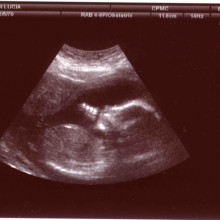
21:34 - Silent genes protect 'foreign' foetuses
Silent genes protect 'foreign' foetuses
Never mind wearing unusual clothes or talking in incomprehensible slang, the feeling that your own child may be 'foreign' starts much younger than their teenage years, starting right back in the womb. 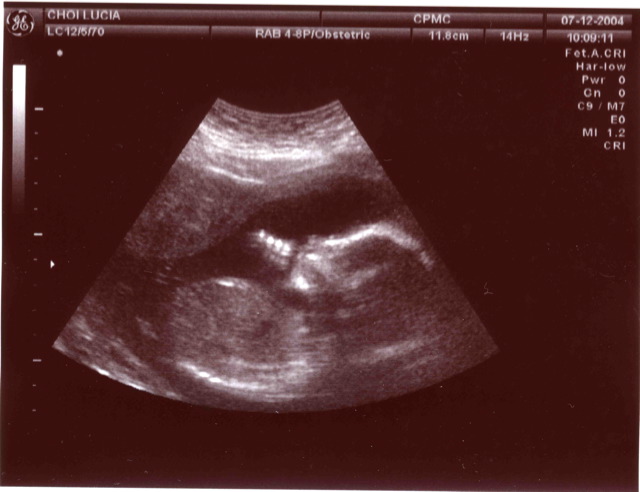 Because a developing fetus is made of cells bearing genes from both Mum and Dad, it should be recognised as a foreign invader by the mother's immune system and destroyed. The fact that is isn't has been a mystery to developmental biologists for many decades. But now new results in the journal Science from Adrian Erlebacher and his team at the New York University School of Medicine have finally revealed how a fetus is protected from this potentially deadly attack. Their findings could not only help to explain what happens when some pregnancies fail, but could even be extended to improving organ transplants or a treating much more undesirable growth, namely cancer.
Because a developing fetus is made of cells bearing genes from both Mum and Dad, it should be recognised as a foreign invader by the mother's immune system and destroyed. The fact that is isn't has been a mystery to developmental biologists for many decades. But now new results in the journal Science from Adrian Erlebacher and his team at the New York University School of Medicine have finally revealed how a fetus is protected from this potentially deadly attack. Their findings could not only help to explain what happens when some pregnancies fail, but could even be extended to improving organ transplants or a treating much more undesirable growth, namely cancer.
Normally, when our body detects something foreign, such as a transplanted organ, it starts an inflammatory reaction around the invader, producing signalling molecules called chemokines. These chemokines attract deadly immune cells called T-cells, which set about attacking and destroying the foreign tissue. This is why it's so important that transplant patients take drugs that suppress their immune system.
To find out why a mother's body doesn't label her baby as foreign, the scientists turned their attention to a structure called the decidua - the specialised 'barrier' tissue that encapsulated both the developing fetus and its placenta, using mice as a model system. They discovered that chemokine genes had been switched off in the decidua, using a kind of chemical 'tagging' known as epigenetic modifications, so killer T-cells weren't recruited there. This immunological 'dead zone' means that the fetus is protected from immune attack as it grows.
At the moment this research has only been done in mice, so the scientists need to confirm whether the same gene silencing is at work in humans. But if it is, there could be big implications for our understanding of why some pregnancies fail, or even why some women give birth prematurely or suffer complications such as pre-eclampsia.
The major problem with cancer is that it starts from our own cells, so it's hard for our immune system to recognise and destroy tumour cells. It may be the case that a similar mechanism that protects a developing fetus from immune attack is also helping cancers to avoid destruction, but obviously this needs to be investigated. The results from this research could also open doors in other areas, including organ transplantation and autoimmune diseases, so it will be very exciting to see where it leads in the future.
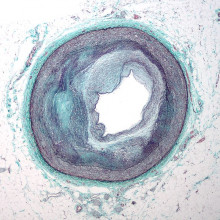
24:14 - Rewriting arterial disease
Rewriting arterial disease
An overlooked cell lurking in the walls of arteries could be the cause of the vascular disease that leads to heart attacks and strokes, new research has 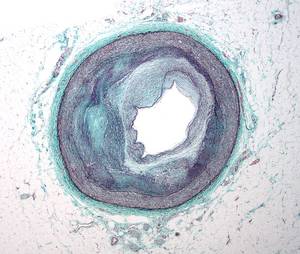 revealed.
revealed.
Writing in Nature Communications, University of California, Berkeley scientist Zhenyu Tang and his colleagues show that a previously-ignored form of stem cell, which they dub the MVSC - multipotent vascular stem cell, may be the smoking gun behind the artery-furring process of atherosclerosis.
Prior to now, scientists had believed that, in response to injury to the inner lining of a blood vessel by factors such as diabetes, smoking or high blood pressure, the smooth muscle cells that form a circulate coat around the vessel begin to proliferate, forming a bulge that slowly blocks the artery.
But when Tang and his team used a range of chemical markers to examine the features of the cells present in the walls of arteries and veins they found a small population of non-muscle cells hiding amongst the muscle.
These cells, they found, show all the signs of being stem cells capable of producing a raft of different tissue types, including even bone, nerve-supporting cells and cartilage. And when they made injuries in vessels in experimental animals, the team found that in fact these stem cells were the ones that were proliferating and producing the artery-blocking bulges that characterise patches of atheroma.
The stem cells were probably overlooked before, the team speculate, because they also produce new muscle cells so when researchers had examined artery specimens in the past and seen proliferations of muscle they concluded that the muscle itself must be responsible.
The discovery of these MVSCs, which, critically, are also present in human arteries, could open the door to a range of new approaches to better managing arterial disease and may explain a host of vascular pathologies, including, given their preponderance to turn into bone cells, the calcifications that characterise some vascular lesions.
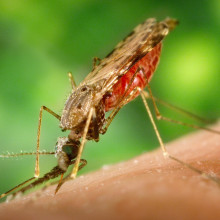
26:22 - Mapping Seasonal Malaria
Mapping Seasonal Malaria
with Matt Cairns, London Scool of hygiene and Tropical Medicine
Also this week, scientists at the London School of Hygiene and Tropical Medicine have developed a new tool that can help them to identify the parts of Africa that are most likely to be susceptible to epidemics of malaria. Knowing where these places are means that efforts to prevent malaria can be concentrated on just these disease hotspots which will save money and thousands of lives. Matt Cairns led this study...
Matt - So Malaria is one of the biggest killers in Africa, particularly in pregnant women and children under 5 years of age. Current estimates from the World Health Organisation suggest there are 170 million malaria cases and perhaps 600,000 deaths in Africa each year, so it's a really big problem.
Chris - So, given that burden of disease, how could we intervene in order to try to reduce those numbers?
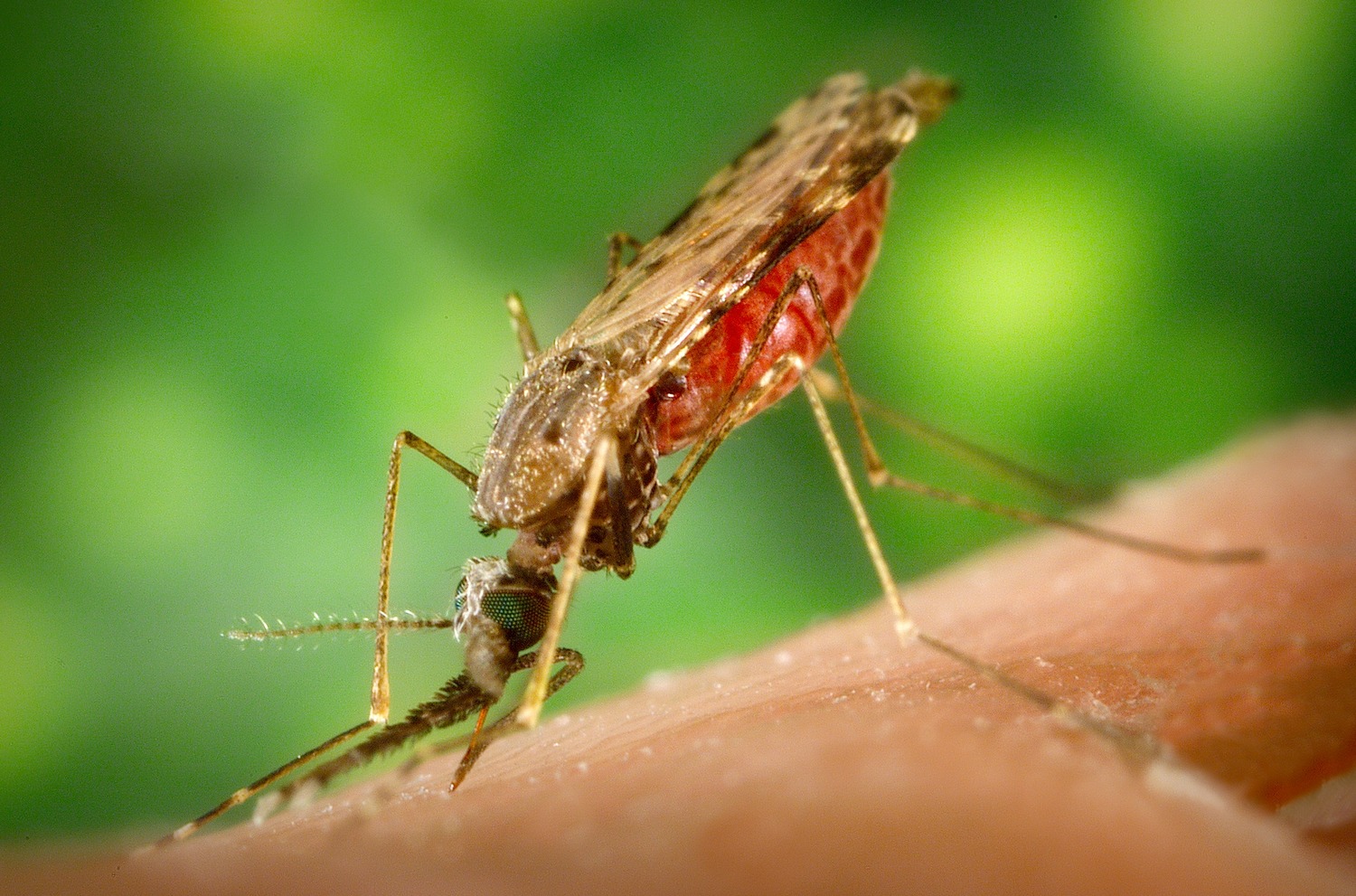 Matt - What we looked at was a new strategy called 'Seasonal Malaria Chemoprevention', or SMC, which involves giving all children under the age of five a 3-day course of anti-malarial drugs, once per month during the rainy season. Where this approach has been used, it's worked very well and prevented around 8 out of every 10 malaria cases, and importantly, a similar number of the severe malaria cases where children actually need to be admitted to a hospital. But to move from research to the real world, we need to know how widely this can be used. So in this study, our aim was to identify the areas of Africa where this approach could be useful. By identifying the parts of Africa, where most of the malaria cases occur within a few months of the year, we can understand where this approach of giving monthly courses of drugs for 3 or 4 months would be most effective.
Matt - What we looked at was a new strategy called 'Seasonal Malaria Chemoprevention', or SMC, which involves giving all children under the age of five a 3-day course of anti-malarial drugs, once per month during the rainy season. Where this approach has been used, it's worked very well and prevented around 8 out of every 10 malaria cases, and importantly, a similar number of the severe malaria cases where children actually need to be admitted to a hospital. But to move from research to the real world, we need to know how widely this can be used. So in this study, our aim was to identify the areas of Africa where this approach could be useful. By identifying the parts of Africa, where most of the malaria cases occur within a few months of the year, we can understand where this approach of giving monthly courses of drugs for 3 or 4 months would be most effective.
Chris - Because it's critical that you know where there is a fairly constrained disease activity zone because then it means you can put your resources in there in an efficient way. If it's spread out fairly diffusely over a very large area with a not very tight peak of disease activity, it must be much harder to intervene.
Matt - Exactly, and so, the problem we're trying to overcome is that for large parts of Africa, we don't actually have reliable information on the pattern of malaria over the course of the year. But we found that the areas where most malaria cases occur within a few months tend to have quite a distinctive rainfall pattern. And in these places, most of the annual rainfall actually falls within 2 or 3 months and that's because the mosquitoes that transmit malaria rely on standing water to breed. So, in areas where there's a short rainy season followed by a long dry season, mosquitoes are only found in large numbers for a few months. So we realised that we could use rainfall to understand what the pattern of malaria cases over the year would be like in areas where we didn't actually have that information, and we were then able to use information on rainfall which is available for all of Africa to map the areas where the pattern of malaria cases is likely to be suitable for this seasonal drug-based prevention.
Chris - What about the problem of resistance though because that's a major issue with antimalarials, isn't it?
Matt - Yes. So, in the areas where this is currently going to be used, there's very little resistance to the two drugs that are planned to be used which is sulfadoxine pyrimethamine combined with amodiaqine, and in most of west Africa, those drugs remain very effective, and so that's why those drugs have been chosen to be used in this strategy.
Chris - Based on this analysis, what area is amenable to this kind of intervention, where you go in with the drugs, and therefore how many people could it impact? How many malaria cases and therefore lives could you prevent being lost?
Matt - We identified two areas of Africa, first of all, the Sahel and Sub Sahel which is a wide belt that extends from Gambia and Senegal in West Africa, all the way across the parts of Sudan in the east, and that belt actually contains some of the areas with the highest number of malaria cases in all of Africa. And secondly, according to the rainfall patterns, there's another quite large area of southern and eastern Africa that might be suited to this approach, and that was not widely recognised before we conducted our research, and is something we're trying to look at in more detail. In terms of the effectiveness, we identified that about 40 million children live in areas where this could be appropriate and about 25 million of those are in the Sahel and Sub Sahel belts where the malaria burden is very high indeed. And in terms of the actual impact, we tried to be realistic rather than optimistic about the number of cases and deaths that will be prevented. So, for example, we assumed that if the drugs were available, not every child would necessarily receive the medication every month, and we also tried to err on the side of caution regarding the effectiveness of the drugs. But even with our cautious approach, we still found that you might be able to prevent 10 million cases of malaria and 50,000 deaths every year. So it's really exciting, the potential impact of this new approach.
Chris - Can poor countries afford this intervention strategy though?
Matt - Yes, the drugs themselves are not expensive and actually, to treat a child for three or four courses over the year will cost something in the order of $1.5 to $2, so it's not expensive. The countries may need some support to begin doing this from the global funds to fight AIDS, TB and malaria or the U.S. President's Malaria Initiative. The costs involved are not particularly large and certainly, when compared with other malaria control tools, this is a reasonable value thing to do.
Chris - And lastly, Matt, it's all very well if we keep shovelling the money in to help these people, but what about if there's another economic downturn, things get even tighter and people say, "We can't afford to keep supporting this." So they don't put the money in. What then happens to the people who have had their malaria prevented at a young age by your strategy and they then turn into adults with malaria? Is there not a danger they could get worse disease and the mortality rate could rebound and be even higher?
Matt - So that's something that's been looked at carefully in the studies that have happened to date. Although that is something that does obviously need continuous monitoring because most of the research studies have been over this space of, at most, 3 or 4 years. So there is a concern if this is done over a very long period, it could be problematic. But those concerns are also raised for insecticide treated nets because it's really a similar idea that you'd be reducing the amount of exposure that children have had. And quite long-term follow up of trials of insecticide treated nets showed that actually, although there may be a slight increase in the malaria that adults or older children experience, it's massively outweighed by the malaria you prevent in childhood. So the cost-benefit analysis still comes down in favour of using these preventive approaches.

32:59 - Smart Water Pumps and the Colourful Personality of Birds
Smart Water Pumps and the Colourful Personality of Birds
with Johan Auwerx, Ecole Pytechnique de Federale; Patrick Thomson, University of Oxford; Marco Zorzi, University of Padua; Claudia Metke-Hoffman, Liverpool John Moore's University
Milking away Obesity
A protein found in milk can keep obesity and diabetes at bay, as well as improve physical endurance.
When given to mice on a high fat diet, the protein nicotinamide riboside was found to prevent weight gain and type II diabetes by entering cells and increasing the activity of mitochondria - the powerhouses of the cell - to improve metabolism.
The protein could one day become a supplement but as it is found in a range of foods as well as milk, including bread and beer, a varied diet holds the key until then.
Johan Auwerx from the Ecole Polytechnique de Federale lead the work published in Science.
---
'Smart' Wat er Pumps
er Pumps
Mobile phones are being used to improve water supplies in rural Africa, according to research in the journal of hydroinformatics.
Patrick Thomson from the University of Oxford developed 'smart' water pumps containing data transmitters that use the increasing access to mobile networks now available across Africa to send out text messages when a pump breaks down.
The technology uses the movement of a pump's handle to estimate its water flow with data sent back to a central office when this flow is impaired to arrange for its repair with 70 being introduced in Kenya later this year.
---
Improving Reading abilities in Dyslexia
Increasing the spacing between letters significantly improves the readings skills of people with dyslexia.
Writing in the journal PNAS, Marco Zorzi from the University of Padua asked 94 French and Italian children with dyslexia to read pieces of text with both standard and double spaced wording and found that widened spacing doubled the accuracy of their reading and increased their reading speed by 20%.
The team suggest the spacing overcomes the problem of 'crowding' where letters are closely surrounded by other letters, making them harder to identify.
---
A colourful personality
And finally, the personality of a Gouldian finch can be predicted by the colour of its head.
Three aspects of personality were measured in 40 of these endangered Australian birds in the wild - risk-taking, aggression and boldness by exposing them to unfamiliar objects, silhouettes of predator birds and limited access to food.
The team, led by Claudia Mettke-Hofman from Liverpool John Moore's University found that Finches with red heads tended to show more aggression to access food whilst those with black heads were more bold and risk-taking.
And that work was published this week in the journal Animal Behaviour.
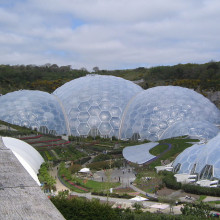
37:33 - New Greenhouse Gases - Planet Earth Online
New Greenhouse Gases - Planet Earth Online
with Johannes Laube, University of East Anglia
Chris - As if carbon dioxide and methane aren't enough to worry about, it now seems that we're managing to make a whole load of new greenhouse gases too. A team including Johannes Laube at the University of East Anglia has identified several new manmade compounds that are contributing to global warming. These halogenated compounds, a bit like CFCs that are now banned, are only found in tiny concentrations, but their chemistry means that they're likely to stick around in the air for hundreds, if not thousands of years. Planet Earth podcast presenter Richard Hollingham went to meet Johannes in his basement laboratory...
Johannes - Basically - I have to reach up a bit - so these are air samples from Tasmania and is a man-made archive which goes back to 1978.
Richard - This metal cylindrical flask is among dozens hanging from the shelves that line the lab. Air inside these containers is reckoned to be some of the cleanest on the planet.
Johannes - You can get very clean air from Tasmania which actually has gone to Antarctica and back again to Cape Grim in Tasmania, then you get a representative picture of what the compound is doing on a long-term basis in the atmosphere.
Richard - The samples are studied using a machine at the centre of the room which resembles an over-sized photocopier. This mass spectrometer is able to separate and analyse air samples to identify minute concentrations of gases to find chemicals that shouldn't naturally be there.
Johannes - We're separating very small amounts of trace gases in the air from the main parts of it which are oxygen and nitrogen mainly and then we still have quite a mixture of different compounds - we have to separate them from each other. When we've done that we actually destroy them. By destroying them we can see a characteristic pattern and that pattern changes over time and gives us the information about which compound is coming through and how much.
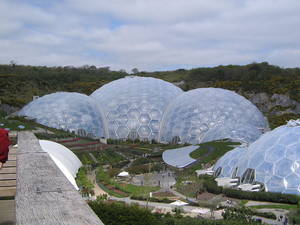 Richard - What are you interested in looking for, then?
Richard - What are you interested in looking for, then?
Johannes - I'm mainly interested in halogenated gases because some of them have very long atmospheric lifetimes, so once released it takes decades and sometimes centuries or even thousands of years for the atmosphere to break them down again. And these gases, are very often very strong greenhouse gases, so they are actually thousands of times more effective than carbon dioxide.
Richard - You're finding these chemicals for the first time in the atmosphere?
Johannes - Oh yes, because industry is introducing more and more new chemicals, it's very hard for scientists to keep pace. In addition, our ability to find them has improved significantly, so we can actually find parts per quadrillion in the atmosphere.
Richard - So parts per quadrillion?
Johannes - Yes.
Richard - But when you've got that tiny, tiny concentration of these gases, does it matter if they're greenhouse gases?
Johannes - Well, for instance, we've recently detected new perfluorocarbons in the atmosphere, but their abundances are on the order of just below parts per trillion. But that means several thousand tons of these molecules have been released into the atmosphere already and in addition they are very long lived, they won't go away for the next several thousand years. Once added into the atmosphere they become a permanent part of it.
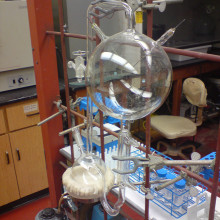
41:34 - Getting Life Started on Earth
Getting Life Started on Earth
with Professor Jeff Bada, University of California, San Diego
One of the most fundamental questions about how life began in the first place must be answered here on Earth. In the 1950s, the chemist Stanley Miller made history when he recreated some of the conditions of the early Earth in a complicated glass apparatus in which he mixed water, ammonia, methane and hydrogen. He heated it and then he zapped it to simulate lightning, and from those simple experiments one of the building blocks of life emerged, the amino acid glycine. Recently, Jeffrey Bada who's a Professor of Marine Chemistry at the University of California, San Diego - and a former student of Stanley Miller - rediscovered the samples from Miller's original experiments in his lab, and he has since spent quite a bit of time re-analysing them using modern chemical techniques that weren't available to Stanley Miller when he first did those experiments. Chris Smith heard from Jeff what he found when he reanalysed the original samples from Miller's experiments...
Jeff - We found a lot more amino acids, of course, using modern analytical methods. What was interesting was that some of those amino acids look very similar to the kinds of amino acids that we see present in carbonaceous chondrites, a type of meteorite. So, I think this was a nice demonstration that this early experiment had mimicked chemistry not only possible on the early Earth, but elsewhere in the solar system.
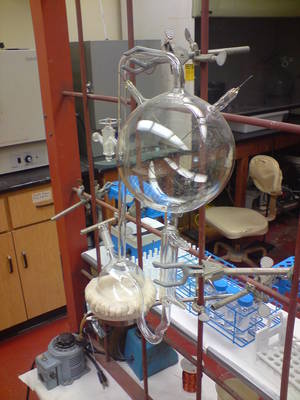 Chris - Just talk us through exactly what Stanley Miller did and why it's so useful as an indicator of what could have been going on when the planet was much younger.
Chris - Just talk us through exactly what Stanley Miller did and why it's so useful as an indicator of what could have been going on when the planet was much younger.
Jeff - Well, the idea was to simulate some sort of early Earth environment. One that Stanley Miller and Harold Urey came up with was a glass apparatus that simulated the ocean/atmosphere interaction. And so, there was a flask that contained water which would represent the ocean, that was connected to a larger flask where there were electrodes that could simulate lightning in the form of a spark discharge. And then from the gas flask, there was a tube running back into the water flask. So this was a cycle where you evaporate water from the ocean, that interacts with gases in the atmosphere which were subjected to a spark discharge or lightning bolt, and then this washes out of the atmosphere back into the water. And so, this was not an ad hoc design. It was a very carefully thought out design. What's interesting is that Miller studied three different apparatus configurations. The one I just described is what we call the 'classical apparatus' because it's the one you see in textbooks. But there was another apparatus that was interesting to us, and that was one in which the water flask was connected directly to the gas flask by a little aspirator, a little tiny tube in which water, when it boiled out of the water flask, was injected into the spark gas flask in the form of a jet of steam, much like a geyser that happens on the Earth today.
Chris - Or a volcano, presumably.
Jeff - Or a volcano, yes. And so, we were very interested in this because Stanley only published one brief communication on that apparatus, and it strongly suggested that the yields were better than in his classical apparatus, but he never followed through with it for whatever reason. So, when we found all these archived extracts from his original experiments, we were stunned to find all of the ones preserved from not only his classical apparatus, but also from the volcanic apparatus and another configuration. And we were particularly interested in that volcanic apparatus because, like I said, based on his preliminary results, we thought the yields might be higher and so, when we analysed that, lo and behold! We found a lot more different amino acids, ones that had never been made before. In addition, the composition of those amino acids looked even more strikingly similar to what we saw in meteorites. And so, I believe this really is a nice example of how you could have localised systems on the early Earth, consisting of small volcanic systems, where you did a lot of synthesis which before people thought happened in a sort of a global atmosphere.
Chris - It's Darwin's warm little pond almost, isn't it? So, you're saying that what they show is that even with very, very simple setups, you can produce really quite complicated molecules which are some of the fundamental building blocks of life systems. And so, it's perfectly possible for Earth, from very, very basic building blocks, to assemble some really complicated molecules that we would have needed?
Jeff - That's correct, yes. And the more we get into this, the more compelling that argument - that experiment is today. One of the other things we found was that there were a set of experiments that he did in 1958, in which he isolated these various extracts from the experiment and he carefully catalogued them, set them aside, and put them in these little boxes and then he never analysed them or never reported on them. They're carefully recorded in his notebook, but he never followed through with the final analyses. One in particular caught our attention because it was the first experiment of this type that used the gas hydrogen sulphide, H2S, which smells like rotten eggs. When we analysed that set of samples, we found an even a larger array of amino acids. So you put all these together, both the volcanic, coupled with the H2S experiment; he made on the order of 50 different amino acids which is remarkable, given the simplicity of the experiment.
Chris - And what's the relevance to finding this in the chondrites, the meteor samples? Why is that important?
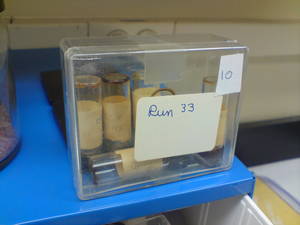 Jeff - Well, I think there's been a controversy about whether the atmosphere of the early Earth ever had the composition that Miller used in his original experiments and so, I've heard comments that the pre-biotic soup is irrelevant, that the Miller experiment is irrelevant. Well, the finding, that we found strikingly similar compositions in this spark discharge experiment compared to the carbonaceous meteorites, indicates that this type of synthesis took place somewhere in the solar system. So, the Miller experiment, even though you argue it may not be relevant to the Earth - which I strongly disagree with - certainly took place some place in the solar system. My own thinking is that in the early solar nebula, you made bioelectric discharges. We know that there is intense lightning in solar nebula that produce the reagents you need for amino acid synthesis - aldehydes, ketones, hydrogen cyanide - and those coalesced into the meteorite parent body. And during the time that the meteorite parent body where water percolated to the meteorite, you made the amino acids. So, it's very analogous to what he did in these experiments, but it happened some place in the solar system.
Jeff - Well, I think there's been a controversy about whether the atmosphere of the early Earth ever had the composition that Miller used in his original experiments and so, I've heard comments that the pre-biotic soup is irrelevant, that the Miller experiment is irrelevant. Well, the finding, that we found strikingly similar compositions in this spark discharge experiment compared to the carbonaceous meteorites, indicates that this type of synthesis took place somewhere in the solar system. So, the Miller experiment, even though you argue it may not be relevant to the Earth - which I strongly disagree with - certainly took place some place in the solar system. My own thinking is that in the early solar nebula, you made bioelectric discharges. We know that there is intense lightning in solar nebula that produce the reagents you need for amino acid synthesis - aldehydes, ketones, hydrogen cyanide - and those coalesced into the meteorite parent body. And during the time that the meteorite parent body where water percolated to the meteorite, you made the amino acids. So, it's very analogous to what he did in these experiments, but it happened some place in the solar system.
Chris - Would the idea then be that it's not just potentially Earth that is making these biological building blocks? It could also be that our entire solar system made them. They happen to land on Earth as much as anywhere else and Earth was the right place for life to then get spawned?
Jeff - I think that's probably true, yes. You had both home grown synthesis directly on the Earth and stuff falling in from space which all contributed to this primordial soup that led eventually to more complex molecules that eventually spawned the first self-replicating entities which was the origin of life.
What is intelligent life?
We're very pragmatic [at the SETI Institute]. For us intelligence is the ability to construct and operate some kind of transmitter that modifies their environment in ways that we can see over under stellar distances.
Were Miller's results right- or left-handed??
Jeff - No. The amino acids that were made in the Miller experiment were equal handedness, what we call a racemic mixture. That's what you expect from a pure chemical synthesis. You only get handedness when you have some sort of interaction than in itself has some sort of handedness and in this experiment, there was no such interaction and so, you get completely equal handedness in the amino acids that are produced.
Chris - I suppose that must give you confidence too, that the tubes haven't been contaminated because if you had seen all of one sort of handedness and not another, you'd know that probably the source was a biological source that have crept into the tube later.
Jeff - Yes, that's correct because if there was any biological contamination, it would consist primarily of the left-handed amino acids and so, you should alter that equal mixture of abundances. But there is also amino acids in this mixture that in fact, a majority of them are not found in living organisms, and so, you then rule out contamination on that basis alone.
What technology could help find alien life?
Well, we're using the radio part of the spectrum and the optical part of the spectrum. We'd like to take our techniques into the infrared. There's less absorption and scattering by dust between the galaxies in the infrared than there is in the optical. And basically, none of our experiments do a really good job at transient signals, things that just go bump in the night once. We know how to do that search. It just takes more computer power than we have on Earth at the moment.
Have hydrothermal systems been found on celestial bodies other than Earth?
Well, I think it's an interesting one. The extremophiles that could potentially be detected by direct planetary probes; so going to our local neighbours and actually trying to look for microbial life, that where we're identifying these will potentially be around Jupiter, the Callisto, Ganymede orbiters, potentially to go underneath the ice surfaces of these moons of Jupiter.
How does SETI get around the problem of radio noise?
Well in fact, our signals are contaminated and that's why, at the SETI Institute, using the Allen Telescope Array, we do our signal processing in near real-time and we keep very good databases of all of the signals that we found and have seen recently. And we do a lot of comparison, a lot of reclassification, and then if we think it's something we haven't seen before, we actually immediately go back and look again. And we look on source, we look off source while the signal is likely to still be persistent, we chase it down.
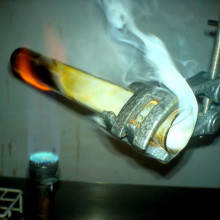
54:52 - Can we create life from basic elements?
Can we create life from basic elements?
Hannah - We put this to Professor Lee Cronin from Glasgow University:
Lee - This is a really important question because it allow us to define life beyond the current toolbox that is used in biology on planet Earth.
But, to answer this question, we need to side step the definition of life and instead ask a different question which is, what is the minimal unit of matter on planet Earth that can exhibit and undergo Darwinian evolution in an autonomous fashion? And the result is both obvious and startling. It's a very simple cell - bacterial cell, amoeba and so on.
So, what we've tried to do in my lab is to engineer all inorganic cells to see if we can put these features together. So, by using molybdenum or tungsten oxides, we've been able to make very large clusters containing many hundreds of units. But not only that. We can have different building blocks templating the clusters. So we almost have an analogy to DNA, RNA and proteins in the clusters built in. So the question now is, can we get this system to boot up to replicate and evolve? And for that, you need to watch the space.
Hannah - So, our version of life uses DNA and protein building blocks. But you can create a different type of building block by making clusters of basic metallic elements that can form structures similar to membranes and enzymes. But, getting these clusters to replicate, mutate, and evolve by themselves has not yet happened. So, we're not quite there yet.










Comments
Add a comment